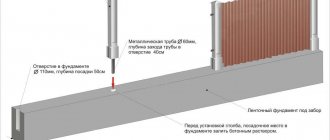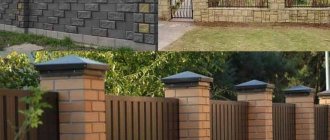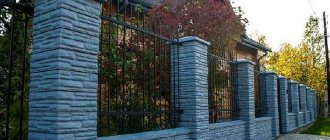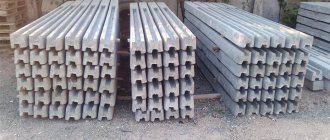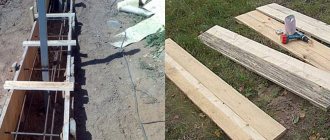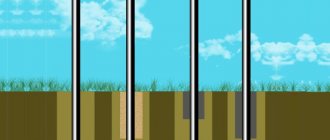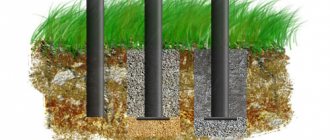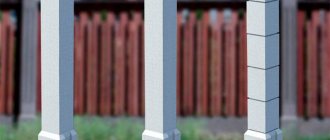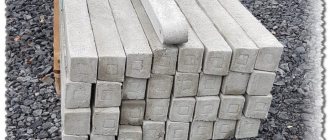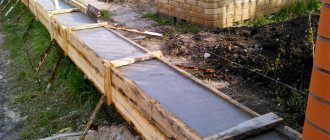- 1 General information
- 2 Installation methods
- 3 Versatile method - concreting
- 4 Concrete stepson
- 5 Concrete base
Wooden building material, despite its fragility, is constantly used in buildings. Used as a base for fences, decoration of extensions, as foundation parts. During work, the tree must be periodically attached to the concrete. Many questions immediately arise: how to properly install wooden poles, how to extend their durability? Answers to them require preparation.
general information
At first glance, the situation is complicated, but there are tricks that help you cope with the work without much difficulty. Before you begin installation, you should choose what kind of wood the future base will be made of and carefully process it. Wood processing is an important process, because when exposed to the environment, it deteriorates.
Processing is carried out on the prepared post. The support is divided into two halves, each of them is treated with a different chemical. The part that is underground is more susceptible to moisture; it is treated with bitumen-based solutions twice, maintaining an interval of a day. The second part of the post is usually coated with varnish, protecting the wood from wind, sun and moisture.
Important! Before processing, the wood must be dried, and careful sanding will help save bitumen impregnation.
Return to contents
Design Features
A picket fence with posts has a very simple design: posts are placed at equal distances from each other, and the spans are filled with boards.
A wooden-concrete fence can be made in one of the options: with or without a base. Both designs have their pros and cons. The lower boards in a fence without a base are constantly exposed to moisture - in summer the wood will suffer from puddles and wet grass, and in winter and spring snowdrifts will contribute to the destruction of the boards, so high-quality processing will be required.
The main options for manufacturing wooden concrete fences
The option with a base is more durable, but also requires more time for construction. In addition, concrete does not look as aesthetically pleasing, which means additional cladding with tiles or artificial stone will be required.
For a fence with a base, in addition to the recesses, it is necessary to prepare a foundation with a depth of 50 centimeters to 1.5 meters and possibly more, depending on the depth of freezing. The bottom is covered with a cushion of sand or gravel, which is then compacted. Formwork is prepared and poured under the fence. After pouring, you will have to wait about a week for the composition to set.
For fences without foundations, preparatory work is limited to drilling recesses. The fragility of individual boards during operation is compensated by the possibility of their quick replacement.
Installation methods
The base is a box for installing supports.
After completing the preparatory work, we proceed to installation. We mark and prepare the place for the supports. Options for installing poles are determined by the design features and the nature of the work. Installation means concreting a support or fixing it to concrete. There are main methods:
- universal concreting of the base;
- use of concrete stepson;
- installation on concrete;
- use of frame;
- special connection;
- platform with a box.
Return to contents
How to fix a wooden pole on concrete: concreting the pole and mounting it on the base
In the process of performing various construction works, sometimes it becomes necessary to attach a wooden pole to concrete. As a rule, this operation raises many questions among novice masters. In this article we will look at how to attach wooden poles to a concrete base in several ways.
Wooden pole mounted on concrete
Versatile method - concreting
Installation of wooden poles using concreting is well suited for soils with low humidity. The installation method involves preliminary preparation of holes for the base, installation of pillars in them and filling the remaining space with concrete.
To increase efficiency when digging holes, the ground is watered; the ground becomes soft and easy to work with. When the height of the pillars is 1.5 m, the depth for the hole is 0.5 m; for higher ones, the depth is increased to 0.8 m. The pillar is deepened by 1/3 of its length.
When the groundwater level is high, the supports are deepened below the soil freezing level and the bottom of the holes is covered with a layer of crushed stone up to 15-20 cm, which acts as drainage. The bottom of the supports is wrapped with roofing felt, fired, and treated with resin to better protect the wood.
Having completed the preparation, they begin to compact the holes. The holes are filled with crushed stone, pieces of brick mixed with soil, and compacted tightly. We leave 15-20 cm to the top of the hole, and the empty space is filled with concrete. After the solution dries, the pole holds tightly and will not bend under the load. The joint between concrete and wood is treated with a sealant, which prevents moisture from getting between them.
Return to contents
Wood selection
When installing posts, pay attention to the type of wood used in construction. Soft rocks react poorly to moisture, which is abundant in the soil: they quickly rot, become moldy, and collapse.
Important! Solid wood (oak, beech) is best suited for this purpose, but it has a significant drawback - its high price.
Wooden fence posts
To reduce costs, choose a more affordable material, for example, pine wood. It is quite dense, not subject to putrefactive processes, does not crack after drying, and does not suffer from deformation.
Concrete stepson
The second way to install a wooden pole is to use a concrete stepson. The essence of the concreting procedure is to use not the entire log, but a small column. The sequence of the procedure is as follows:
- before installation, the support is treated with an antiseptic, the part of the stepson that will be in the ground is covered with bitumen and wrapped with roofing felt;
- crushed stone is poured onto the bottom of the hole;
- vertical fixation of the support with spacers;
- Be sure to fill the wooden post with crushed stone, gravel and compact it well. Maintaining a compaction interval (every 30 cm), adding sand and water will help increase the density of the backfill;
- 15-20 cm to the top, the hole is filled with a concrete solution, which ensures stability.
After the concrete has hardened, it is necessary to secure the log with wire to small posts.
Return to contents
Installation of metal and wooden supports
Installing the supports yourself will take you one day. In the prepared area, the places where the support posts will be installed are marked with pegs. Next, dig a hole 50 cm deep with a shovel or using a drill. The bottom of the hole is compacted and covered with fine crushed stone or sand.
If you have chosen metal pillars as racks, then metal bearings are welded to them for stability. The pillars are immersed in the pits and their position is checked by level, which must be strictly vertical. You can use supports to keep the posts upright. Next, the pillars need to be concreted.
Advice: so that all the pillars are immersed in the ground to the same depth, before starting work, you can make marks on the metal profile itself at a level of 50 cm. Metal supports are installed at this depth.
Wooden supports can be installed with your own hands in another way. You will need to lay a columnar foundation made of blocks or monolithic pillars, which subsequently needs to be concreted. Typically, the depth of laying such a foundation is about 50 cm. Fastening is done using metal plates or anchor bolts. The advantage of this method is the prevention of rotting of wooden poles. But, despite all precautions, wooden supports have to be replaced after 10-15 years.
If metal supports need to be treated with an anti-corrosion compound, then wood also needs pre-treatment. This will extend the life of wooden poles, and painting will add to their attractiveness.
Concrete base
Installation of a wooden support using a concrete base can be easily done in several ways:
- Special mount embedded in concrete. By special fastening we mean a pin with a special fastening in the form of the letter P at its end. The cross-section of the beam must correspond to the dimensions of the fastening so that the tree fits easily into the device. The inserted beam is attached with screws and bolts. The method has its drawback - only timber is used as a wooden support.
- Fittings. In the absence of a specially prepared connection, ordinary reinforcement is used. The inserted iron pin into the concrete should protrude 20-25 cm above the surface. A hole is drilled on the support, the diameter of which corresponds to the diameter of the reinforcement. A seal is applied to the concrete to protect the structure from water penetration. The size of the seal is smaller than the wooden support. The joints between the pillars and concrete are covered with mortar. If necessary, the upper and lower frames will help connect all the pillars into a common structure. This option is more often used on a strip foundation.
- A box with a platform is used for hardened concrete. The wooden material is placed in a specially made box, to which a platform is welded from below. Dowels are screwed into the holes on the platform, with the help of which the box is attached to the concrete.
Fixing wood to concrete is not difficult if all technologies are followed. It is worth taking care not only of reliable fixation of the material, but also of minimal environmental impact on the wood. Then the wooden supports will serve you for many years.
What are the advantages of wooden poles
Photo: logs pointed at one end.
Among the main ones there are:
- high strength, which means resistance to strong gusts of wind;
- low weight of material;
- ease of assembly and installation allows you to create a fence with your own hands, without outside help;
- service life, subject to periodic processing, is up to 30 years;
- environmentally friendly, natural raw materials;
- affordable price;
- good compatibility with brick, metal, corrugated board, stone, picket fence;
- aesthetic appearance;
- the ability to paint in any colors;
- no need for special equipment.
Photo: poles made of timber with embedded logs.
Among the shortcomings they note:
- susceptibility to rotting;
- the need to pre-treat with protective agents;
- strength is lower than that of metal or concrete pillars;
- likelihood of minor repairs;
- need for regular care.
If you neglect the recommendations for periodic maintenance, then the service life of wooden racks will be reduced to 5–7 years.
Manufacturing technology
Different types of trees are used to make structures: birch, hazel, beech, larch. Oak is considered the most durable, but not everyone can afford it due to its high cost. Fruit-bearing and evergreen species are not used in construction. The former have a soft central part, while the latter quickly dry out and become unusable.
To make wooden poles, it is recommended to buy untreated wood obtained in early spring or late winter. The logs are stacked, preserved and left for 5-12 months. This is how drying is carried out, the task of which is to reduce the moisture content of the wood to 15%.


